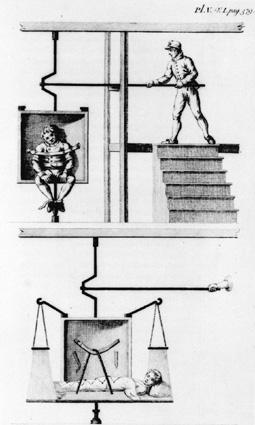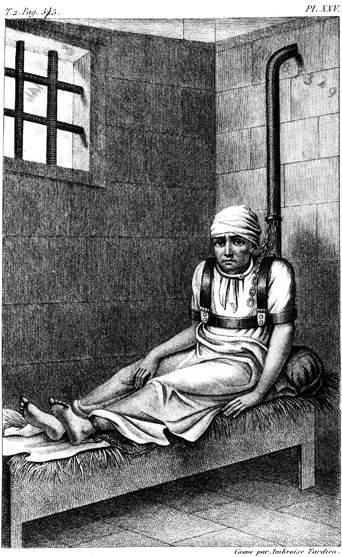
- •Psychiatry
- •Isbn 0–19–280727–7 978–0–19–280727–4
- •Contents
- •Preface
- •List of illustrations
- •Chapter 1 What is psychiatry?
- •All the ‘psychs’: psychology, psychotherapy, psychoanalysis, and psychiatry
- •Psychology
- •Psychoanalysis
- •Psychotherapy
- •What is psychiatry?
- •What is a mental illness?
- •The subjectivity of diagnosis
- •Imposing categories on dimensions
- •The scope of psychiatry – psychoses, neuroses, and personality problems
- •Schizophrenia
- •Manic depressive disorder (bipolar disorder)
- •Treatment of psychotic disorders
- •Compulsory treatment
- •Depression and neurotic disorders
- •Depression
- •Anxiety
- •Obsessive compulsive disorder
- •Hysterical disorders
- •Personality disorders
- •Addictions
- •Suicide
- •Why is psychiatry a medical activity?
- •A consultation with a psychiatrist
- •Chapter 2 Asylums and the origins of psychiatry
- •The York retreat
- •The asylum movement
- •1. Narrenturm (‘Fools’ Tower’) situated alongside the Vienna General Hospital, the first modern general hospital in Europe, built by Emperor Joseph II in 1787
- •2. Georgia state sanatorium at Milledgeville: the largest state mental hospital in the usa. At its height in 1950 it housed over 10,000 patients
- •Psychiatry as a profession
- •‘Germany’ – psychiatry’s birthplace
- •4. Eugen Bleuler (1857–1939): first used the term ‘schizophrenia’, in 1911 Eugen Bleuler (1857–1939)
- •Sigmund Freud (1856–1939)
- •5. Freud (1856–1939): the father of psychoanalysis
- •The first medical model
- •Julius Wagner-Jauregg (1857–1940) and malaria treatment
- •Electro-convulsive therapy
- •Mental health legislation
- •Chapter 3 The move into the community
- •Deinstitutionalization
- •The revolution in social attitudes The Second World War
- •Therapeutic communities
- •‘Institutional neurosis’ and ‘total institutions’
- •Erving Goffman and total institutions
- •The rights and abuse of the mentally ill
- •7. One Flew Over the Cuckoo’s Nest: Jack Nicholson as the rebellious Randle McMurphy in Milos Forman’s 1975 film depicting a repressive mental hospital
- •‘Transinstitutionalization’ and ‘reinstitutionalization’
- •Care in the community
- •District general hospital units and day hospitals
- •Community mental health teams (cmhTs) and community mental health centres (cmhCs)
- •Day hospitals
- •Stigma and social integration
- •Social consensus and the post-modern society
- •Chapter 4 Psychoanalysis and psychotherapy
- •How is psychotherapy different from normal kindness?
- •Sigmund Freud and the origins of psychoanalysis
- •The unconscious and free association
- •8. Freud’s consulting room in Vienna c.1910 with his famous couch. The room is packed with evidence of Freud’s preoccupation with ancient Egypt and mythology Ego, id, and superego
- •Defence mechanisms
- •Psychodynamic psychotherapy
- •Existential and experimental psychotherapies
- •The newer psychotherapies and counselling
- •Family and systems therapies and crisis intervention
- •Behaviour therapy
- •Cognitive behavioural therapy
- •Self-help
- •Chapter 5 Psychiatry under attack – inside and out
- •Mind–body dualism
- •Nature versus nurture: do families cause mental illness?
- •The origins of schizophrenia
- •The ‘schizophrenogenic mother’
- •The ‘double-bind’
- •Social and peer-group pressure
- •Evolutionary psychology
- •Why do families blame themselves?
- •The anti-psychiatry movement
- •9. Michel Foucault (1926–84): French philosopher who criticized psychiatry as a repressive social force legitimizing the abuse of power
- •10. R. D. Laing (1927–1989): the most influential and iconic of the antipsychiatrists of the 1960s and 1970s
- •11. The remains of the psychiatry department in Tokyo – students burnt it down after r. D. Laing’s lecture in 1969
- •Anti-psychiatry in the 21st century
- •Chapter 6 Open to abuse Controversies in psychiatric practice
- •Old sins
- •12. Whirling chair: one of the many devices developed to ‘calm’ overexcited patients by exhausting them
- •13. William Norris chained in Bedlam, in 1814 The Hawthorn effect
- •Electro convulsive therapy and brain surgery
- •Political abuse in psychiatry
- •Psychiatry unlimited: a diagnosis for everything
- •The patient
- •‘Big Pharma’
- •Reliability versus validity
- •Psychiatric gullibility
- •Personality problems and addictions
- •Coercion in psychiatry
- •Severe personality disorders
- •Drug and alcohol abuse
- •The insanity defence
- •Psychiatry: a controversial practice
- •Chapter 7 Into the 21st century New technologies and old dilemmas
- •Improvements in brain science
- •14. Mri scanner: the first really detailed visualization of the brain’s structure
- •15. A series of brain pictures from a single mri scan. Each picture is a ‘slice’ through the brain structure, from which a 3d image can be constructed
- •The human genome and genetic research
- •Early identification
- •Brainwashing and thought control
- •Old dilemmas in new forms
- •Will psychiatry survive the 21st century?
- •Further reading
- •Chapter 1
- •Chapters 2 and 3
- •Chapter 4
- •Chapter 5
- •Chapter 6
Old sins
Like all of medicine, psychiatry’s history includes what now appear dangerous and even barbaric treatments. Before being too critical think what it must have been to live at a time when early and sudden death was a constant threat and excruciating pain had to be endured, often for weeks and months on end. There were few certainties and even fewer effective treatments. What doctors were willing to do two centuries ago, and what patients were prepared to endure, have to be judged against quite different standards. Folk treatment of the mad was also far from gentle, despite our tendency to romanticize pre-industrial societies. Disabled individuals were often accepted and occasionally revered but the more disturbed were often excluded (which could mean death) or mistreated as witches or such like.
Early psychiatrists used the standard medical treatments of their time including bleeding, purging, and cupping (attaching hot cups to the back to ‘draw out’ toxins). The early asylums moved away from these, emphasizing moral treatments (Chapter 2), although various desperate measures were tried to calm ‘furiously’ agitated patients. These included cold baths (still used well into the 20th century) and a series of ingenious devices which worked by simply exhausting the patient, such as the notorious ‘whirling chair’. However, the major sins of the asylum era were those of neglect – restraint rather than attention, undignified and humiliating conditions rather than active abuse.
Long-term fluctuating illnesses are particularly prone to accumulate far-fetched theories and treatments. This is a mixture of desperation and pure chance (an illness may simply recover just when some irrelevant treatment is being used). There was a vogue for removing otherwise healthy organs in the mentally ill in the late 19th century because they were thought to be the site of ‘sepsis’ (low grade infection). Thousands of healthy teeth and tonsils were removed and even large parts of the bowel. In Trenton State Hospital, New Jersey, Dr Henry Cotton championed this approach right up until his death in 1933 (including taking out all the teeth from his own two sons and even subjecting one to an abdominal operation). These treatments were controversial but still supported by distinguished psychiatric figures.

12. Whirling chair: one of the many devices developed to ‘calm’ overexcited patients by exhausting them

13. William Norris chained in Bedlam, in 1814 The Hawthorn effect
A complicating factor is that the fuss and attention surrounding treatments can make a real difference even if the treatment itself is ineffective. This was shown with insulin coma treatment. Insulin had been long used in psychiatry to stimulate appetite and calm agitated patients (who could otherwise literally starve to death). A course of insulin comas was believed to be effective in schizophrenia and this became a common treatment from the 1930s through to the 1960s. It was a potentially dangerous treatment requiring skilled and attentive nursing – if the coma went too deep the patient could die. It was the first psychiatric treatment subject to a controlled trial to establish its effect. Half the patients were put into a light sleep using tranquillizers and half into an insulin coma, without the staff knowing which was which. The results were the same for both groups, forcing the conclusion that it was the nursing attention and hope inspired by the treatment that made the difference, not the insulin. The treatment was abandoned. This effect is known as the ‘Hawthorn’ effect and psychiatric research always has to account for enthusiasm.
Enthusiasm shouldn’t be written off in psychiatry. Much of medicine may be best conducted in a dispassionate, scientific frame of mind but psychiatry requires hope and optimism from its staff. Patients have so often lost hope and need help regaining it. Hope is therapeutic in its own right as the insulin coma study indicated. Many studies have confirmed that optimism makes a difference to outcome (even in cancer patients). It can, however, lead to over-enthusiasm and treatments, including effective treatments, being given well beyond their indications.
